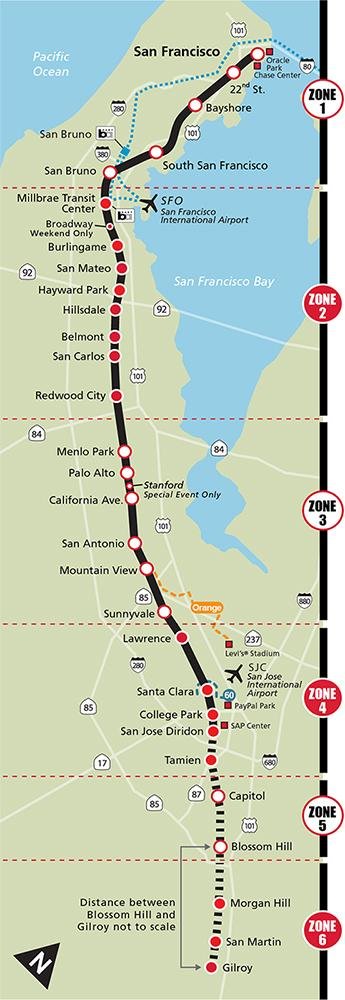Fare integration opportunities for Caltrain ridership growth
Fare policy will play a key role in efforts to regrow Caltrain ridership, according to board finance committee discussions in December. The region’s coordinated fare and payment initiatives pose promising opportunities.
Overall, increased ridership on electric trains, lower costs for electricity than forecasted, and financial discipline have improved Caltrain’s financial outlook, according to a first look at a draft operating budget for FY2025 and a draft 10-Year Strategic Financial Plan in December at the Caltrain board’s finance committee meeting
Fares, payment, and ridership recovery
Caltrain is focusing on regrowing ridership, which stands at 44% of pre-pandemic levels.
Fare policy is critical in Caltrain’s efforts to regain ridership, for individuals and for organizations.
Organizational fares - single or multi-agency?
In December, Caltrain’s board finance committee discussed plans for the future of the Go Pass, the employer pass that was the agency’s largest source of revenue before the pandemic. At the committee, staff shared that the number of customers has declined from over 40 to under 10, and the program needs to be re-invented.
However, the discussion of organizational passes did not mention the region’s successful BayPass all- agency transit pass pilot, which has a long waiting list with over 100 potential customers, and recently expanded the second phase of the pilot for up to four times as many participants.
The BayPass is serving customers including the City of Menlo Park, which had been a Go Pass customer before the pandemic but prefers BayPass because it meets more of its employees travel needs; San Francisco-based Open AI, which was relatively small before Covid and chose BayPass as its first transit pass, and customers such as San Francisco Airport which would be unlikely customers for Go Pass, and a multi-agency pass is a better fit.
Individual fares - zone or distance, single-agency or standard?
For individual riders, Caltrain will also be considering the fare structure. Like other older rail services that were considered “commuter rail”, Caltrain has a zone-based fare structure that originated with 19th century systems where conductors would punch tickets and “commute” the fare when a rider travelled less than the full distance of the line.
This fare structure results in jumps at zone boundaries, with high fares for short trips that happen to cross a boundary. Caltrain’s Citizen’s Advisory Committee has long recommended moving to distance-based fares. The region’s Fare Integration Task Force recommended standardizing regional fares starting with BART and Caltrain, which was modeled to significantly increase ridership.
Apparently, a concern of Caltrain’s staff is that without faregates, some customers might take advantage of lower short-trip prices to skip payment, and not get caught by fare enforcement. This question would benefit from analysis, since Caltrain already serves many short trips within a single zone; moving to fairer fares for a few more short trips seems likely to have more benefits from increased ridership than drawbacks from people cadging free rides from Millbrae to San Bruno.
Open payment and impulse trips
At the finance committee meeting, outgoing board member Dev Davis also talked about ways to encourage and market the trips for recreation and entertainment that are growing rapidly with Caltrain’s better weekend schedule.
The board discussion did not yet mention the upcoming release of Open Payment, which will allow people to pay for transit with credit/debit cards and Apple/Google/Samsung Pay, a more convenient solution for visitors and impulse trips. This opens opportunities to promote transit to and from airports, sports and entertainment arenas, and hundreds of local attractions.
Davis brainstormed creating special-purpose fares in partnership with VTA and other agencies. But a multi-agency weekend or weekly fare cap would be less effort to customize with each pair of agencies, and offer benefits to visitors and transit ridership all around the region.
Summary - integrated fares and payment
There are potentially substantial opportunities for Caltrain to increase ridership by participating in and helping to develop and market the all-agency transit passes, standardized regional fares, and open payment and fare capping promotions. This requires a shift toward thinking about the needs of the agency in the broader picture of the needs and preferences of transit customers.


